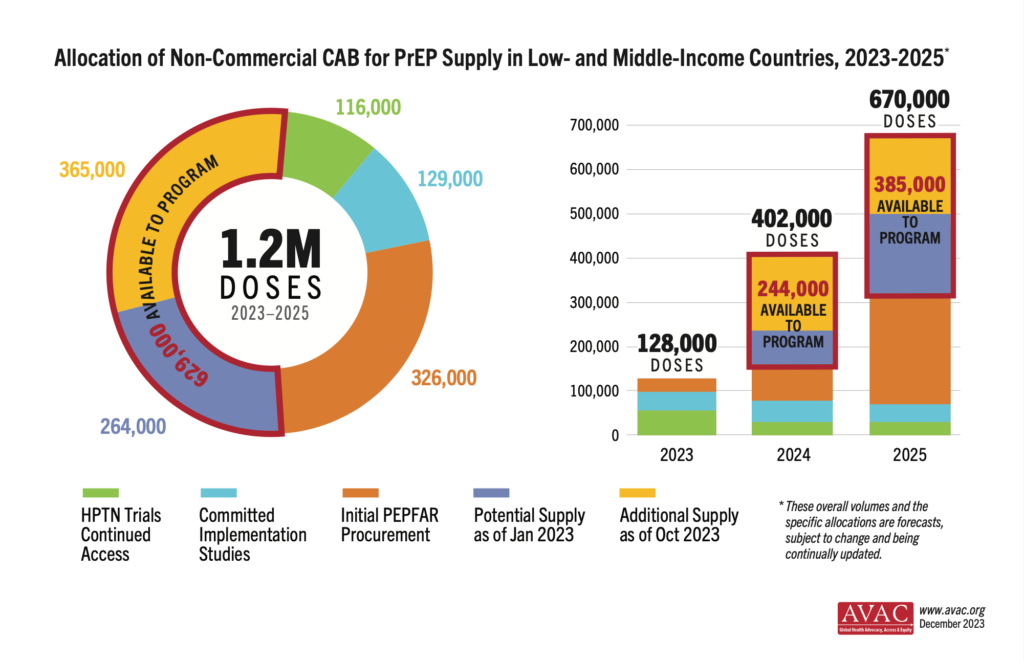February 15, 2024
AVAC is thrilled to see the launch last week of injectable cabotegravir for PrEP (injectable CAB) in Zambia—the first program outside of the US to do so. And earlier this week the Desmond Tutu Health Foundation in South Africa also announced “the first jab” of injectable CAB administered in its FASTPrEP study. This news comes on the heels of another important gain—the announcement of a new licensing agreement that will double the supplies of the dapivirine vaginal ring (DVR) across Africa.
All represent significant milestones that we hope will be the first of many in 2024. Leveraging these achievements so that people who need and want HIV prevention can access choice is the prevailing question on our minds at AVAC. Choice is the key: it requires robust investment in the policies, planning and programs that ensure every proven product—oral PrEP, injectable CAB and the DVR—are included in the package of HIV prevention options, along with sustained research and development of new interventions.
So what is the status of access among PrEP options as 2024 begins?
As it stands, oral PrEP is offered in 122 countries with cumulative initiations reaching more than 6 million (2012 – December 2023). (Check out the Global PrEP Tracker for details.) Trends in initiations saw great progress over the last two years, but to reach UNAIDS targets of 10 million PrEP users by 2025, initiations of oral PrEP alone will not be enough. People will need to find an option they can use for as long as they need it. PrEP coverage, seeing the most people possible using an option that works as long as they need it, regardless of product type, is the goal—with programs and products to support them.
Injectable CAB supplies are an important factor. Late in October 2023, Injectable CAB’s developer, ViiV, forecasted a 40% increase in available doses to low- and middle-income countries, reaching 1.2 million doses through 2025. These doses are headed to implementation science (IS) studies that are evaluating how to scale up delivery and to national programs supported by PEPFAR and Global Fund, including Zambia’s.

Zambia is now the second country in the world, after the USA, to roll out injectable CAB outside the planned and ongoing IS studies. And more countries are expected to follow in Zambia’s path, including Malawi and Zimbabwe. Check out our Country Planning Matrix that tracks this progress of injectable CAB as well DVR.
In addition, 11 countries have approved the DVR, and 38 implementation science studies are delivering or planning to deliver injectable CAB and/or the DVR. Check out our Integrated Study Tracker that catalogues these projects.
As these products start arriving in country, key issues must be addressed:
- increasing supplies and obtaining lower prices for both products;
- ensuring the delivery mechanisms for rolling out injectable CAB and DVR are integrated into prevention programs that are well-designed to reach those who could benefit from PrEP products;
- establishing how to deliver acceptable HIV prevention services to a wide range of populations, including adolescents, pregnant and lactating people, sex workers, LGBTQ+ communities and people who inject drugs; and
- advancing a learning agenda across programs that are delivering HIV prevention—inclusive of injectable CAB and DVR—to ensure information, lessons and insights are shared.
But above all, effective delivery must be defined by delivering choice through programs where end-users are supported to select the option that best fits their lives. AVAC’s Wawira Nyagah and Mitchell Warren outlined these issues—and the lessons from oral PrEP that need to be leveraged—in a recent commentary in Bhekisisa: Bending the curve: What a decade-long roll-out of the anti-HIV pill can teach the world.

As 2024 begins, at AVAC we see possibility. PrEP initiation trends, country approvals for new products, program launches, and efforts at transparency and coordination could pay enormous dividends. But fulfilling this promise is not certain. It depends on overcoming systemic challenges around access and choice.
Let’s not waste 2024.